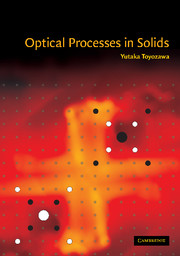Book contents
- Frontmatter
- Contents
- Preface
- Acknowledgments
- List of principal symbols
- 1 Radiation field
- 2 Quantum mechanics
- 3 Interaction of radiation with matter
- 4 Electronic vs. nuclear motions and the optical spectra of localized electrons in solids
- 5 Lattice vibrations
- 6 Electric susceptibility and dielectric constant
- 7 One-electron states in solids
- 8 Excitons
- 9 Polaron and the self-trapped state
- 10 Optical spectra of exciton in the phonon field Overview
- 11 Higher-order optical processes
- 12 Inner-shell excitation
- 13 Photo-induced structural changes
- 14 Light, matter and life (A scenario for the origin of life and its evolution)
- Appendix 1 Derivation of exciton Hamiltonian from many-body Hamiltonian
- Appendix 2 Transient spectra for second-order optical processes
- References (by chapter)
- Subject index
Preface
Published online by Cambridge University Press: 10 December 2009
- Frontmatter
- Contents
- Preface
- Acknowledgments
- List of principal symbols
- 1 Radiation field
- 2 Quantum mechanics
- 3 Interaction of radiation with matter
- 4 Electronic vs. nuclear motions and the optical spectra of localized electrons in solids
- 5 Lattice vibrations
- 6 Electric susceptibility and dielectric constant
- 7 One-electron states in solids
- 8 Excitons
- 9 Polaron and the self-trapped state
- 10 Optical spectra of exciton in the phonon field Overview
- 11 Higher-order optical processes
- 12 Inner-shell excitation
- 13 Photo-induced structural changes
- 14 Light, matter and life (A scenario for the origin of life and its evolution)
- Appendix 1 Derivation of exciton Hamiltonian from many-body Hamiltonian
- Appendix 2 Transient spectra for second-order optical processes
- References (by chapter)
- Subject index
Summary
Light is the most important medium of recognition in human life, as is obvious from the prominent role of vision among the five human senses. In its most naive form, one can recognize by light the position and shape of an object on the one hand and its color on the other. From the time that light was revealed to be a type of waveform, these two functions have been ascribed to the spatially and temporally oscillating factors of the wave, and have been applied to the diffraction study of the microscopic structures of matter and the spectroscopic study of microscopic motions in matter, respectively. It was Maxwell who revealed light to be an electromagnetic wave, which could be deduced from his fundamental equations for an electromagnetic field in a vacuum (Chapter 1).
Einstein, in his theory of relativity, incorporated three-dimensional space and one-dimensional time into a four-dimensional spacetime coordinate system on the basis of his Gedanken experiment with light as a standard signal for communication between observers. In contradistinction to the Newtonian equation of motion, the Maxwell equations survived this revolution of physics, proving themselves to be invariant against Lorentz transformation among different coordinate systems in relative motion. Thus, light acquired the position of universality governing the spacetime framework itself, something more than an unknown and intangible medium which was once called “the ether”.
Another important role of light in the history of physics is the spectral distribution of a radiation field in thermal equilibrium with matter.
- Type
- Chapter
- Information
- Optical Processes in Solids , pp. ix - xiPublisher: Cambridge University PressPrint publication year: 2003

